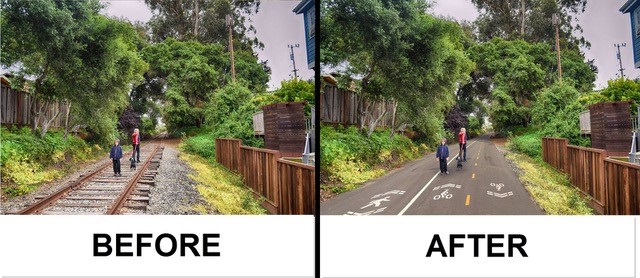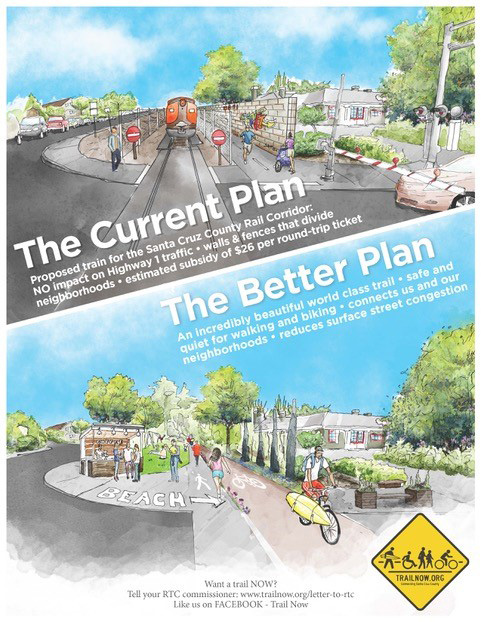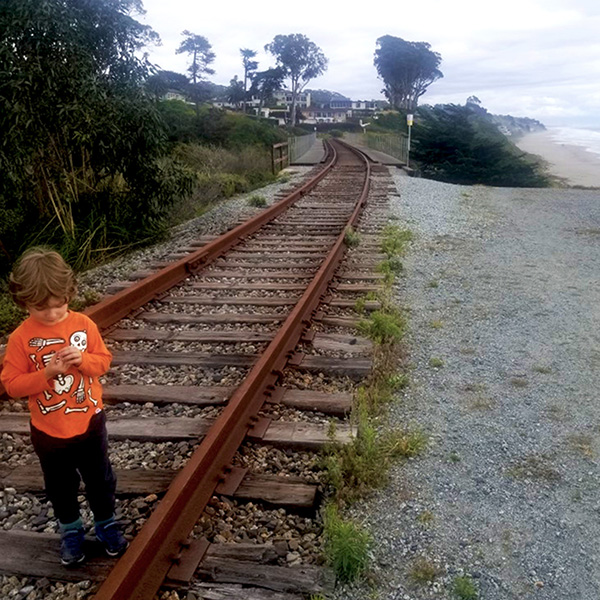Forget the Rail, Trail is the Way to Go Now
By Brian Peoples

It has been a decade since the Santa Cruz County Regional Transportation Commission bought the Santa Cruz Branch Line. But reserving the rail corridor for a train is preventing the construction of a world-class Santa Cruz Coastal Trail.

10 reasons why the Santa Cruz Coastal Trail should be built NOW:
- Never-Ending Costly Studies. three train studies conducted over the last five years and costing $2.5 million have proven that a train would not reduce traffic, would cost over $1 billion and would increase adjacent surface-street traffic and congestion.
- Legal Restrictions. Federal guidelines require that any trail built next to a commuter train be separated at least 25 feet from train tracks. The Santa Cruz rail corridor from Santa Cruz to Manresa Beach is only 27 feet wide, making it legally impossible to accommodate both a commuter train and trail.
- Rail banking is possible now. After 10 years, the SCCRTC has acknowledged that rail banking is both legal and possible for the Santa Cruz Coastal Trail. That is covering the tracks and using them at a future, more affordable and necessary time. Rail banking guarantees important federal funding for so-called “takings” lawsuits, where the government can take back the money it paid for rail. If the rail corridor is not rail banked, the cost and liability for adjacent property owner lawsuits falls on Santa Cruz County taxpayers.
- Increased Traffic and Congestion. The current train and trail plan diverts the trail to surface-streets for 35 percent of the corridor (12.5 miles), all of which is located in the most populated and busiest sections of Santa Cruz County, including downtown Capitola.
- Historic Train Trestles. There are over 20 train trestles along the corridor, some of which like Capitola’s are historic. These decaying trestles would have to be replaced with concrete trestles in order to safely transport the planned 60 trains a day travelling 45 mph. Tearing down historic trestles to be replaced by concrete trestles tugs at the heart of Santa Cruz County residents, who are so very proud of our heritage and history.
- The Environment. As avid environmentalists, Santa Cruz County residents are continuously concerned about changes to the existing landscape that have a longterm negative effect on the environment. Since the tracks run within 20 feet of the Pacific Ocean, “sea-level-rising” mitigation plans make train travel financially and environmentally unfeasible. At the same time, the current plan results in hundreds of heritage oak trees being cut down and millions of cubic feet of earth moved to create a tunnel of concrete retaining walls.
- Cost Prohibitive. Building a trail adjacent to train tracks is not affordable. The Santa Cruz Westside trail segment was selected as the first section to build because it was viewed as the least expensive. Yet, in reality, the cost to build this section has been outrageously expensive–$10 million per mile as compared to the $2 million average national cost of building rail-to-trails.
- Safety. The proposed operational plan is to run 60 trains a day, travelling 45 mph, through our neighborhoods, many of which are quiet residential areas. We can unfortunately cite horrific statistics, including one example coming from the Marin/Sonoma SMART train–which has had 11 people killed in the last 2 years by speeding trains through neighborhoods. We shudder at the thought of having 60 trains a day travelling through Aptos Village.
- Transportation Trail. One of the studies completed, the Unified Corridor Study, included statistics that indicated a trail would have 800 users/HOUR. Studies by Nelson Nygaard and Alta Planning and Design, two of the most reputable transportation consultants in the U.S. have indicated that a wide multi-use trail will carry more commuters than a train at a fraction of the cost.
- Passenger Train Fares. Rail transit is not affordable for low income commuters. Passenger roundtrip tickets would cost $20 per day for a short 12-mile ride.









6 Comments
Barry Scott
In response to the claims in this article:
1. Multiple transportation studies were required to make the best investments and were requested by trail-only proponents. The claim of cost over $1Billion is simply unsupportable.
2. The SMART bike path places the trail right next to the tracks where space is limited and this is 100% acceptable to the Federal government when conditions require it. Also, the corridor is not 27 feet wide. 96.5% of he corridor is 32 feet wide or greater. 58% is 51 feet wide or greater.
3. Rail banking is risky and not practicable without consensus of the rail operator and the county and we need to keep the tracks for transit, not take them away. We have a legal rail line, let’s improve and use it today while continuing to build the trail.
4. Either plan, trail only or rail with trail, would divert the trail to San Andreas road. The Capitola “diversion” is temporary until the bridges are modified to permit cyclists and pedestrians. This is under study, with $50,000 in reserve for an engineering investigation which should commence once the current Transportation Corridor Alternatives Analysis concludes.
5. Any rail bridge or trestle that needs repairs will need them regardless of the ultimate use. Bus or rail or trail only, repairs will be needed. The timber trestles are capable of carrying extremely heavy loads and the claim of replacing these with concrete is simply not supported by the facts.
6. Environmental concerns are best served by providing rail transit and the trail in our corridor. This was proven in past studies, most recently in the Unified Corridors Investment Study published in January 2019.
7. The Santa Cruz County share (by population) of the projected Caltrans State Rail Plan fund is just over $1 Billion. These are moneys we contribute that will go to counties that apply for them. There is no such fund for buses on the corridor, neither are such funds available for a trail only use. We should use our own money to provide smart light electric rail transit.
8. Claims of safety concerns using a 79 mph heavy commuter train like SMART to the neighborhood friendly rapid street car or ultra light rail system appropriate for our county are not legitimate arguments against transit. Transit vehicles will go slower through populated areas and not traveling at 45 miles per hour in Aptos Village.
9. Trail Now compares trail-only use with rail-only use to make a point, but should compare trail-only to rail plus trail usage because we are building both. Obviously, when you add two sets of users, the sum is greater than either one alone. Rail plus Trail will serve more than either one alone.
10. $20 daily tickets is a fabrication. The 2015 study suggested $2.50 fares each way. The prices will be competitive with Metro and affordability to students and low-income households will be guaranteed. People who can give up the cost of car ownership, insurance, fuel, parking, etc., stand to save many thousands of dollars per year, money that can be spent on investments, education, health care, etc.
We are about to find out from the Regional Transportation Commission where the best return on investment will be for the rail corridor, and I’m confident that modern wireless electric rail service integrated with Metro routes and including the trail will be the winner.
David
Brain Peoples’ comments are so far off I couldn’t begin to start to answer without taking two hours to do so.
But I will point out something he didn’t address or just brushed over. That’s the subject of easements and the ownership of this railroad.
For those who are not familiar with what easements are, they are a type of property lease, allowing one person or entity to cross the property of another person or entity. They are pretty common for things like pipelines, power lines, and railroads.
They are also usually pretty specific. If the use for the easement is removed, the property reverts to the owner.
In this case, the easement agreements are for a railroad. The agreements do not say they are for a corridor, or a trail. Take up the tracks, the property goes back to the owners or designated parties in the original agreement. The right of way, the right for the railroad or the trail, legally goes up in smoke.
In short, no railroad, no easement, no trail.
Be careful what you wish for–especially if you keep wishing for it after things have been laid out in plain language, as here.
Especially when it’s been pointed out that easement issues can get expensive.
https://www.seattletimes.com/seattle-news/was-public-railroaded-in-trail-deal/
Jack Brown
David (who appears to frequently not use his full name to reply to rail subjects on this site) is incorrect. Railbanking preserves the rail easement while making it possible to convert the abandoned rail line to a trail. Progressive Rail has absolutely no issue with the process of rail banking north of Watsonville and it makes perfect economic sense.
Rail banking has been used on thousands of miles of abandoned track. https://www.railstotrails.org/build-trails/trail-building-toolbox/acquisition/railbanking/
Let’s stop chasing good money after bad and work to restore our bus system that has faced years of neglect by the same people that say they promise to get transportation right if you gives us hundreds of millions of dollars for a train.
We are at a critical point in decision making, it’s time to send a message this November in District 1 to remove the incumbent John Leopold from District 1 that continues to make a mess of the RTC.
Nadene Thorne
The most significant fact arguing against a train in our rail corridor is the COST – one seldom addressed in specific terms by train advocates. Santa Cruz County voters will have to approve a sales tax increase (by a 2/3 majority) to support a train. We will compete for the state’s rail plan fund with other more populous counties; we’d only be a 25-mile spur that numerous RTC studies have not shown will reduce Highway 1 traffic. Take a look at the SMART train in Sonoma-Marin: county populations three times ours, with far more disposable income. Their system is awash in red ink, charging $15 a trip, and voters recently refused to approve another bond issue to bail it out. Why do we think Santa Cruz can do better?
And if none of that isn’t convincing, three people have been killed in accidents on the neighborhood tracks since 2017.
In the meantime, while we wait for the studies to go on and on and on (Measure D only provides money for studies, not for actual construction), the corridor remains weed-choked and off-limits. Short, disconnected segments of outrageously expensive trail are under construction at a glacial pace, forecast for implementation over the next 10 years or more. This is the best we can do?!
David P Lubic
“The most significant fact arguing against a train in our rail corridor is the COST – one seldom addressed in specific terms by train advocates.”
Based on that logic, we can’t afford the trail, either.
It will cost money to build and maintain. Some trails have come in close to $1 million per mile; that’s if you’re going to reengineer things as you should and put some sort of paved surface on there so something other than a mountain bike or a hiker in really good shoes can use it.
Besides, we’re not going to be able to drive our way out of congestion. We’re going to need alternatives. Besides, who finds driving enjoyable anymore?
May as well keep the rails in place.
Jack Brown
Keeping the rails in place is currently costing over $10,000,000 per mile in the easy section of the “Rail with a Trail” construction being performed now and explodes to over $30,000,000 per mile as you get into the more challenging sections.
Removing the rails help reduce the cost selling the steel and ties as scrap. Less excavation, retaining walls and tree removal is required with a trail only design.
Alternatives have already been approved. Bus On Shoulder/Bus Rapid Transit (BOS/BRT) has already been approved by the RTC. BOS/BRT can be tuned and scaled as required as demands change. Rail cannot.
Rail is an obstacle to transportation in Santa Cruz, not an accelerator.